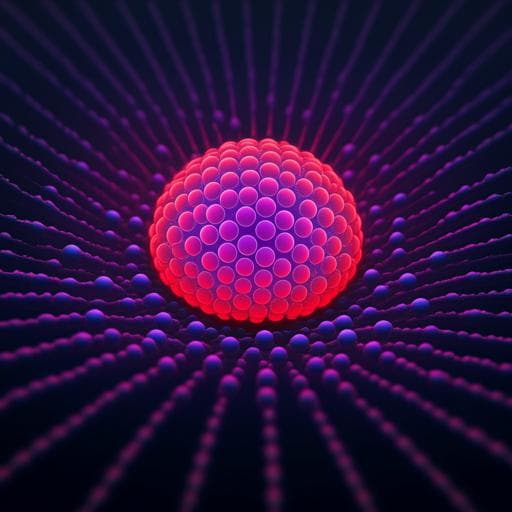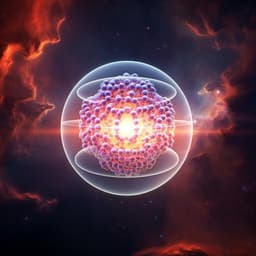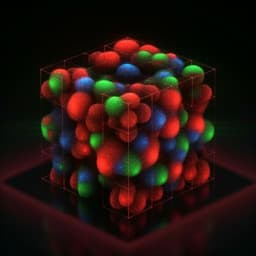
Engineering and Technology
Strain-graded quantum dots with spectrally pure, stable and polarized emission
D. Jung, J. W. Park, et al.
Explore the groundbreaking work of Dongju Jung and colleagues as they reveal how structural deformation in strain-graded CdSe-ZnSe quantum dots enhances optical properties, enabling stable photon emission across the visible spectrum with near-unity efficiency. This innovative research leverages elastic deformation for advanced photonic applications.
~3 min • Beginner • English
Introduction
Colloidal quantum dots (QDs) are free-standing nano-emitters with size-tunable, narrow-linewidth emission. Core–shell heterostructuring tailors photophysical characteristics but often introduces structural complexities (asymmetric shell geometry, compositional variation, crystal-structure mismatch, and misfit defects) that obscure structure–property relations and degrade optical performance. Asymmetric lattice strain can lift degeneracy of exciton states, elevating dark states above bright ones and splitting bright excitons into heavy-hole and light-hole states, which narrows linewidths, accelerates radiative decay, and lowers gain thresholds—beneficial for displays, lasers, and single-photon sources. However, achieving controlled asymmetric strain in conventional centered core–shell geometries without misfit defects remains challenging. This calls for a materials platform that reaches degeneracy lift in core–shell heterostructures of tailored geometry without misfit defect formation. In this work, the authors aim to realize coherent pseudomorphic growth of ZnSe shells on CdSe cores to impose strong, asymmetric compressive strain while maintaining a compositionally abrupt interface and high structural homogeneity, thereby enabling spectrally pure, stable, polarized, and efficient emission.
Literature Review
Prior studies showed degeneracy lift and related photophysical benefits in geometrically asymmetric core–shell QDs or those with reduced shell symmetry, but thick/thin shell asymmetries can induce misfit defects and poor carrier confinement. Compositionally graded (cg) QDs suppress misfit defects but reduce effective compressive stress and introduce interfacial inhomogeneity that broadens spectra. Earlier reports observed exciton fine-structure splitting even in nominally spherical core–shell QDs, yet systematic correlations between structural factors and photophysics remained unclear due to interfacial alloying, shell morphology variations, and defects. Theoretical frameworks (Efros et al.) predict dark–bright splitting and HH–LH splitting under strain; experiments reported improved lifetimes/blinking under strain and device implications in QLEDs and lasers. This study builds on these by engineering coherent, compositionally abrupt interfaces to maximize asymmetric strain while suppressing alloying and misfit defects.
Methodology
- Design principle and computations: DFT calculations indicated that Cd-rich polar surfaces of CdSe cores stabilize via cation vacancies prone to Zn incorporation during ZnSe growth, forming unwanted Cd1−xZnxSe alloy interlayers. To avoid interfacial alloying, Se-terminated CdSe cores were used so surface vacancies would not favor cation mixing upon ZnSe epitaxy. Calculations also predicted anisotropic compressive strain along crystal axes.
- Core synthesis: Wurtzite CdSe cores with radii from ~1.4–4.0 nm were synthesized under N2 using Schlenk techniques. Cd oleate and TOPSe precursors were used; initial cores formed by hot injection at 300 °C followed by controlled growth via syringe-pump addition of Cd(OA)2 and TOPSe. Purification used precipitation/redispersion (acetone/toluene).
- Shell growth (pseudomorphic ZnSe): ZnSe shells were grown thermodynamically at high temperature (≥340 °C) using low-reactivity zinc oleate (Zn:OA = 1:3) and layer-by-layer steps of ~0.5 nm per 30 min. Growth rates were controlled by cation-to-ligand stoichiometry and feed rates to enable coherent epitaxy without optically active defects and with a compositionally abrupt interface. Multiple steps yielded shells up to ~5.0 nm. Optional ~0.5 nm ZnS outer shells were added for oxidation stability.
- Alloy-core variants: Wurtzite Cd0.25Zn0.75Se cores (r ~1.8–2.4 nm) were synthesized using DPPSe; ZnSe shells (and optional ZnS exterior) were then grown similarly to test reduced lattice-mismatch systems.
- Etching control experiment: Oxidative etching with benzoyl peroxide mixtures at room temperature verified that exciton-energy shifts arose from imposed strain rather than interdiffusion (recovery upon etching).
- Structural characterization: EDS elemental mapping (Cd, Zn), HR-TEM, inverse FFT, and geometric phase analysis (GPA) quantified lattice constants and strain along [0002] and [11-20] directions. High-resolution XRD provided additional structural confirmation.
- Optical characterization (ensemble and single-dot): UV–Vis absorption, PL, and absolute PL QY were measured with commercial instruments. Time-resolved PL used a 405 nm pulsed diode (1 MHz). Single-dot spectroscopy employed a depolarized excitation through an oil-immersion objective, with detection via Hanbury Brown–Twiss setup for g(2)(τ), blinking, and lifetimes. Polarization-resolved spectra used a half-wave plate (HWP) and Wollaston prism (WP) to separate orthogonal linear polarizations (I∥, I⊥); a depolarizer before the spectrometer ensured polarization-independent detection efficiency. Rotation-angle scans (0–360°, 100 ms/°) enabled DOP extraction for split exciton emissions.
- Device fabrication (QD-LEDs): Inverted structure ITO/Zn0.9Mg0.1O/QDs/CBP/MoOx/Al. ZnMgO nanoparticles (spin-cast, 4000 rpm, 30 s; anneal 75 °C, 30 min). QD layers (14 mg/mL, spin-cast, 4000 rpm, 30 s; anneal 75 °C, 30 min). Thermal evaporation of CBP (60 nm), MoOx (10 nm), Al (120 nm). Devices encapsulated; J–V–L, EQE–L, and EL spectra measured with Keithley instruments and Konica-Minolta spectroradiometer.
- Parameter space: Core radii r = 2.0–4.0 nm (and down to 1.4 nm for tunability); shell thickness H = 1.0–5.0 nm; analyses across this space linked structure to photophysics.
Key Findings
- Coherent, compositionally abrupt, strain-graded CdSe–ZnSe core–shell QDs were realized via pseudomorphic heteroepitaxy; interfacial alloying was suppressed by using Se-terminated CdSe cores and controlled ZnSe layer-by-layer growth at ≥340 °C.
- Strong, anisotropic compressive strain in the CdSe core without misfit defects: for r = 2.5 nm and H = 5.0 nm, mean compressive strain β along [0002] is −3.08% and along [11-20] is −4.33%, consistent with DFT; centered geometry yields uniform strain and effective carrier confinement.
- Exciton fine-structure degeneracy lift with large bright-state splitting: HH–LH split ΔEsplit up to ~55–60 meV at H ≈ 2.0–3.0 nm; for bulk-like shells (H ≥ 4.0 nm) ΔEsplit ≈ 50 meV; splitting depends nonlinearly on shell thickness due to anisotropic stress evolution.
- Radiative recombination accelerated: single-exciton lifetime reduced from ~24 ns (bare CdSe) to ~11 ns (sg-QDs), indicating dark–bright decoupling and nearly purely radiative decay; ensemble PL QY near 100% maintained even beyond critical shell thickness (~2.33 nm).
- Spectral purity and stability: single-dot PL linewidth as narrow as 17.7 meV; spectral diffusion strongly suppressed (std = 0.27 meV); dot-to-dot variations small; ensemble PL spectra are record-narrow among colloidal core–shell emitters.
- Blinking and Auger suppression: type-I alignment with smooth interfacial potential funnels carriers to the core, suppressing blinking and Auger processes; single-dot g(2)(0) averages 0.16, consistent with strong antibunching.
- Polarized, spectrally resolved emissions at room temperature: large ΔEsplit (> kT) enables separate observation of 1S_Hx,em and 1S_Lx,em with narrow components (≤19 meV and ≤26 meV, respectively). Polarization-resolved measurements show sinusoidal DOP with 180° periodicity and 90° phase difference; emissions are polarized along orthogonal orientations (1S_Hx: in-plane 2D dipole; 1S_Lx: along C-axis 1D dipole). Higher 1P states also split (≈35 meV) with similar polarization behavior.
- Emission tunability and high efficiency across visible: by adjusting core size/composition and shell, single-dot peak PL energies span ~1.95–2.65 eV with PL QYs >90%. Cd0.25Zn0.75Se–ZnSe sg-QDs exhibit similar trends but smaller strain effects (broader ~30 meV linewidths; HH–LH split smaller by ~14 meV) due to reduced lattice mismatch and confinement barriers.
- Device demonstration: QD-LEDs using sg-QDs show record-narrow EL FWHM ≈ 50 meV, peak EQE 21.6% (near theoretical limit), and peak luminance >4.2×10^5 cd/m^2, evidencing structural robustness and high emission purity.
Discussion
The work addresses the long-standing challenge of correlating structural design with photophysics in core–shell QDs by demonstrating that coherent pseudomorphic growth can impose strong, anisotropic compressive strain without generating misfit defects or interfacial alloying. The asymmetric strain reconfigures the exciton fine structure by splitting bright excitons (HH vs LH) and decoupling them from dark states, which directly leads to accelerated radiative rates, reduced exciton–phonon coupling, suppressed spectral diffusion and blinking, and linearly polarized emissions with orthogonal orientations. The ability to spectrally resolve polarized HH and LH emissions at room temperature confirms the designed anisotropy at the single-dot level. Mapping across core radii and shell thicknesses quantifies how effective compressive strain scales with geometry and how HH–LH splitting evolves nonlinearly with shell thickness due to anisotropic stress. Comparisons with alloy-core systems (Cd0.25Zn0.75Se) validate the role of lattice mismatch in governing strain magnitude and resultant linewidths and splitting. Integration into QD-LEDs corroborates ensemble-level spectral purity and high efficiency, underscoring the practical significance for photonic devices needing narrow spectra and controlled emission dipoles.
Conclusion
This study establishes a materials platform for strain-graded, compositionally abrupt CdSe–ZnSe core–shell QDs via coherent pseudomorphic epitaxy, achieving defect-free interfaces and strong anisotropic compressive strain. Key contributions include: (i) large bright-state exciton splitting (~50–60 meV) enabling room-temperature, orthogonally polarized emissions; (ii) accelerated, near-radiative-limited single-exciton decay with near-unity PL QY; (iii) record spectral purity at both single-dot and ensemble levels with suppressed spectral diffusion and blinking; (iv) expanded emission envelope spanning the visible through combined strain and quantum confinement control; and (v) record-narrow EL, high EQE (21.6%), and high luminance in QD-LEDs. Future research directions include extending asymmetric strain engineering to heavy-metal-free systems (e.g., InP, Ag(In,Ga)S2), developing epitaxy chemistries for III–V and I–III–VI2 nanocrystals, and processing strategies to align transition dipoles in solids to further enhance light out-coupling and device performance.
Limitations
- Modeling approximations: The nonlinear evolution of HH–LH splitting with shell thickness is interpreted via simplified geometries in calculations; exact thicknesses at extrema may differ from experiment.
- Material generality: Reduced lattice mismatch systems (e.g., Cd0.25Zn0.75Se–ZnSe) exhibit smaller strain effects (broader linewidths, smaller splitting), indicating that outcomes depend on specific core–shell lattice parameters and band offsets.
- Dipole alignment: Although single-dot emissions are polarized, scalable alignment of transition dipoles in solid films is not realized here and is needed to fully leverage emission directivity in devices.
- Single-photon purity: While g(2)(0) ≈ 0.16 indicates strong antibunching, it is not zero; residual multi-photon or background contributions may remain under certain conditions.
Related Publications
Explore these studies to deepen your understanding of the subject.







